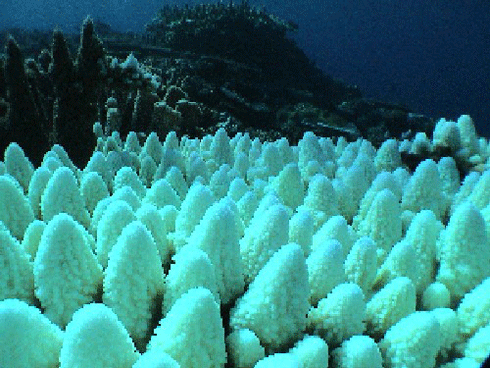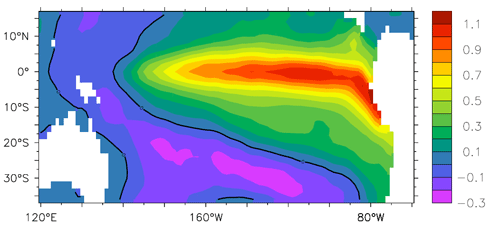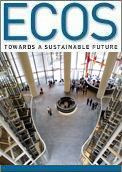
|
Published: 14 March 2012
Coral bleaching: a new form of El Niño implicated?
Coral bleaching in the World-Heritage-listed Great Barrier Reef (GBR) has previously been attributed to large-scale climate patterns such as El Niño and La Niña. But these two phenomena – along with the lesser known ‘El Niño/La Niña Modoki’ climate pattern – are influencing the GBR in more complex ways than we previously thought.

|
|
Coral bleaching is usually a ‘stress’ response to increased water temperature, which is not always associated with El Niño, as previously thought.
Credit:
Bleach Watch/ReefEd.edu.au
|
Our research team is attempting to understand the interactions between the Reef’s biological systems – principally coral reefs – and ocean-atmosphere circulation patterns at small and large scales. 1
Among the factors influencing surface water circulation on the Reef are:
-
seasonal changes (summer versus winter)
-
inter-annual and decadal (every ten years) oscillations, such as El Niño/La Niña Southern Oscillation (ENSO)
-
longer-term trends.
These influences are in turn subject to the global phenomenon of climate change.
Coral reefs are vulnerable ecosystems and have shown great sensitivity to the unusually warm water temperatures associated with climate change.
Coral bleaching, in particular, is a stress response to increased water temperature. The coral expels its zooxanthellae – the single-celled marine algae that live within the coral providing its food – resulting in the death of the coral. Bleaching due to global warming is considered one of the biggest threats facing coral reefs.
Since 1982 there have been several documented bleaching episodes on the GBR.
The 1997-98 bleaching event coincided with a strong El Niño episode. This led to the belief that thermal conditions conducive to coral bleaching were more likely to occur during El Niño, rather than La Niña, events – despite the fact that coral bleaching has occurred in the Reef both during El Niño and El Niño-neutral years.
Thanks to new analytical tools and improved datasets to re-examine the surface climate (pressure, temperature, winds and currents) of the Reef, we have since found that the influence of El Niño and La Niña is complex.
For example, during El Niño events, summer surface temperatures across the Reef differ, meaning it is not possible to generalise when talking about the influence of El Niño on the Reef as a whole.
Furthermore, summers are not consistently associated with either unusually warm or cool sea surface temperature anomalies along the length of the Reef. Thus, La Niña summers do not necessarily reduce the potential for thermal stress conditions conductive to coral bleaching.

|
|
Tropical Pacific monthly sea surface temperature anomalies for the period 1948 to 2009 (from NOAA Extended Reconstructed SST dataset).
Credit:
Redondo-Rodriguez et al.
|
And there’s another factor involved.
In addition to the ‘classical’ El Niño, researchers have identified a new phenomenon ‘El Niño Modoki’, which is similar to El Niño, but with warming occurring in the central rather than the eastern equatorial Pacific. 2
It has been suggested that Modoki events are becoming more common with global warming and may, therefore, be more typical of future ENSO activity.
Modoki has been found to have a different effect on Australian rainfall when compared to the classical El Niño, so we expected Modoki to also have a different signature on the Reef.
In fact, we found a relationship between El Niño (and La Niña) Modoki and sea surface temperatures on the northern half of the GBR: they were cooler with El Niño Modoki; warmer with La Niña Modoki.
So ENSO events are not the primary source of interannual climate variability on the summer climate of the GBR. Further studies are necessary to explore the role of other sources of variability that have already been shown to interact with the Australian climate.
A better understanding of this variability is critical to the task of predicting the impacts of climate change and formulating management strategies to protect one of Australia’s greatest environmental and economic assets.
Ana Redondo-Rodriguez is a PhD Candidate in the area of oceanography and remote sensing at The University of Queensland. The work discussed here was first published in the peer-reviewed journal, Marine and Freshwater Research.
Southern Oscillation Index (SOI) and El Niño/La Niña Southern Oscillation (ENSO) |
Much of the variability in Australia’s climate is connected with the major see-saw of air pressure and rainfall patterns between the Australian/Indonesian region and the eastern Pacific. |
The Southern Oscillation Index (SOI) is a measure of the difference in pressure between the Indian and Pacific Oceans and is calculated from the monthly or seasonal fluctuations in the air pressure difference between Tahiti and Darwin. |
El Niño |
When the SOI values are strongly negative (air pressure is higher over Australia and lower over the central Pacific), the SOI is said to enter an ‘El Niño’ phase, during which there is a high probability that eastern and northern Australia will be drier than normal. The period of strongest influence is the six months of winter/spring (i.e. June to November): rainfall over these months is typically lower than normal. |
During El Niño: |
|
Overall, the focus of convection migrates from the Australian/Indonesian region eastward towards the central tropical Pacific Ocean. |
La Niña |
When SOI values are strongly positive (air pressure is lower over Australia and stronger over the central Pacific), the SOI is said to enter a La Niña phase, during which there is a high probability that eastern and northern Australia will be wetter than normal. The period of strongest influence is the six months of spring/summer (i.e. October to March): rainfall over these months is typically higher than normal and temperatures lower, particularly over northern and eastern parts of Australia. |
During La Niña |
|
1 Researchers from the University of Queensland and the Australian Institute of Marine Science collaborated to publish the recent paper: Ana Redondo-Rodriguez, Scarla Weeks, Ray Berkelmans, Ove Hoegh-Guldberg and Janice M. Lough (2011) Climate variability of the Great Barrier Reef in relation to the tropical Pacific and El Niño-Southern Oscillation. Marine and Freshwater Research 63(1) 34-47.
2 The traditional Niño, also called eastern Pacific (EP) El Niño, involves temperature anomalies in the Eastern Pacific. However, in the last two decades, non-traditional El Niños were observed, in which the usual place of the temperature anomaly is not affected, but an anomaly arises in the central Pacific. The phenomenon is called central Pacific (CP) El Niño, ‘dateline’ El Niño (because the anomaly arises near the dateline), or El Niño Modoki (modoki is Japanese for ‘similar, but different’). The effects of El Niño Modoki are different from those of the traditional El Niño – for example, El Niño Modoki leads to more hurricanes more frequently making landfall in the Atlantic. Some scientists believe the new El Niño to be linked to global warming. However, with satellite data only available back to 1979, more research must be done to ascertain a correlation.



